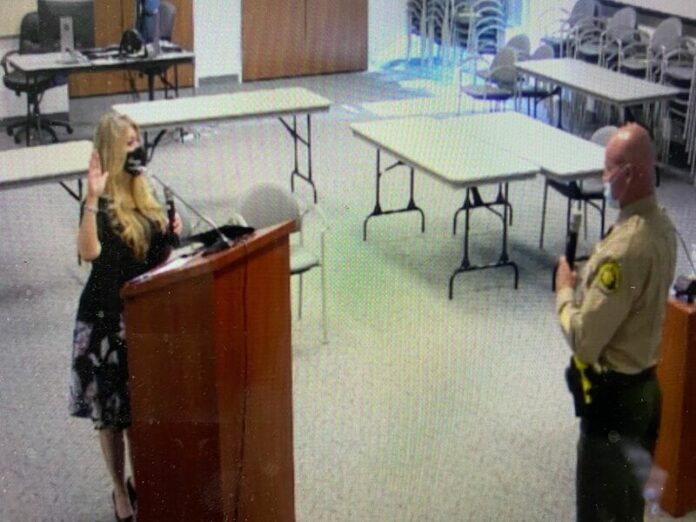
Two Windsor Town Council meetings were held on May 19, one addressing regular town business items and one a joint session between the council and the planning commission to discuss town zoning updates.
The regular Windsor Town Council meeting served two primary purposes — to swear in new police chief Mike Raasch and vote on a series of consent calendar items.
The first was accomplished after Raasch, who is employed by the Sonoma County Sheriff’s Office, introduced himself to the board and the community.
According to a May 11 interview with Town Manager Ken MacNab, “Pursuant to an agreement for law enforcement services, the town of Windsor contracts with the Sonoma County Sheriff’s Office for law enforcement services, including all police personnel. Under the agreement, the sheriff coordinates the selection and appointment of the chief with the town. The town manager designates the final selection of the chief, and the chief remains an employee of the Sonoma County Sheriff’s Office.”
Raasch has worked in Windsor before in his time with the sheriff’s department and has continued to be a part of the community even after his assignments have taken him elsewhere. This proved to be one of the deciding factors for his selection, according to MacNab.
“We had two excellent candidates, both could have done the job, but Mike’s demonstrated commitment to community policing made him stand out,” MacNab said. “And, the fact he continued to be involved in Windsor after he was reassigned made a statement to me. We’re really excited to have Mike on board. I’ve seen him in action, and I’m really imprressed with character and who he is.”
Raasch will replace Windsor Police Chief Ruben Martinez, who announced his retirement after two years of service as Windsor’s chief and a 30-year career in law enforcement.
One item was pulled from the consent calendar for further discussion, the final approval for a change in maximum building heights for one particular type of zoning. This change was approved on first reading at a public hearing at a previous meeting, but concern from residents and questions from council led to further conversation.
However, Councilmember Debora Fudge explained that she and Vice Mayor Sam Salmon had visited with neighbors who were particularly concerned due to a project being built near them and that she felt comfortable approving the items based on that experience and conversations with the planning department.
“(We) went out to talk to neighbors about height and setbacks and walked the property with them and when they understood how the whole project was designed with them in mind, they seemed to feel a lot better,” she said. “But the important thing to come out of our of meeting is (community development director Jessica Jones) agreed on new policies in the department where more input from neighbors was needed in instances such as this … I’m approving tonight based on these new policies coming from the planning department.”
Salmon and Councilmember Esther Lemus concurred, and the item was passed after discussion.
Zoning updates
The purpose of the joint meeting was to begin the process of the zoning ordinance update. Windsor received a $150,000 LEAP grant from the state to undertake the updating process, and the town hired MintierHarnish, a consulting firm specializing in the preparation of general plans, regional plans, housing plans, and zoning ordinances, to assist the town in the development of the zoning ordinance update.
According Bretnon Gibbons from MintierHarnish, the zoning ordinance update is a “technical” update focused on: achieving consistency with the 2040 General Plan; creating consistency with state housing laws and reducing regulatory barriers to the construction of housing; reflecting changes in state law; creating contemporary zoning provisions; making the zoning ordinance easier to use and implement; and implementing changes to address issues identified by staff.
“Comprehensive updates are usually ‘repeal and replace,’ we’re working with the town on a technical update,” Gibbons said. “The project is grand funded so we have to follow those guidelines which is to stimulate housing. We want to make sure align with that grant.”
The issue of state laws and stimulating housing came up over and over again in throughout the presentation and subsequent conversation, where the council and commission gave the consultants some guidance to move forward with a draft.
Primarily, the new state requirements to address the housing crisis and new state laws on restricting development will be driving much of these zoning updates, and everyone agrees it was important for residents to understand that much of this is out of their hands.
In other words it’s no longer about being pro-or-anti-development, because the state has deemed that development will be occurring, and any obstructionist ordinances will no longer fly.
“As we go through this process we will need to explain new state laws and what Windsor is newly bound by, because some people in the public are not understanding that our hands are being bound,” Fudge said. “Now we have things like objective design standards and we are not able to make as many individual decision as in the past.”
Among the items brought to the consultants for discussion and inclusion was a desire to focus on adding housing within the town, including the so-called “missing middle,” transitional or supportive housing and possibly allowing RVs to be utilized as an ADU with homeowner permission.
Public comment focused on the need for not only different types of housing within the town, but the idea of integrated neighborhoods with different ages, socioeconomic groups and more in neighborhoods together.
While he supported all of the above, Salmon came back to the idea of resident education and pointed out the elephant in the room.
“I agree education is the key,” he said. “When a lay person looks up information, they at the definitions in the zoning. They don’t necessarily understand things like density bonuses or changes in state law. They read what’s written in black and white and many times what comes forth is not consistent with that black and white because of those things. The more education we can provide, the better it will be, because we are going to run into compatibility issues and people are going to wonder why Windsor is not remaining a family-friendly, single-family (house) hometown with modest lots. We all like that, but as we’ve already said, affordability is at issue here.”
The next steps in the project are community outreach, including stakeholder interviews and the first community meeting, slated to take place over the next few months. From there the consultants will prepare the administrative draft zoning ordinance, slated to be ready in the fall, with the winter being the time for public comment on the draft. Adoption is projected for summer of 2022, following revisions and public input.








